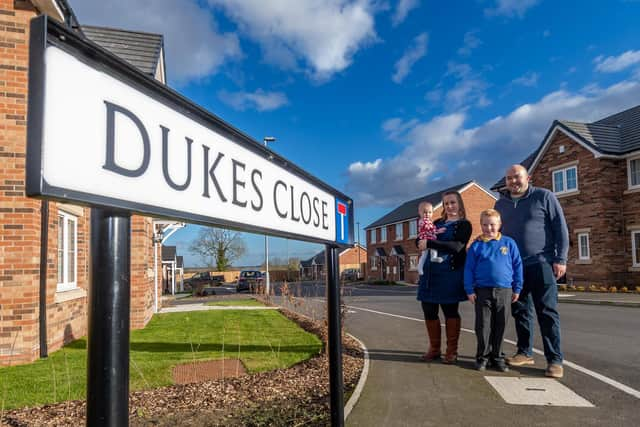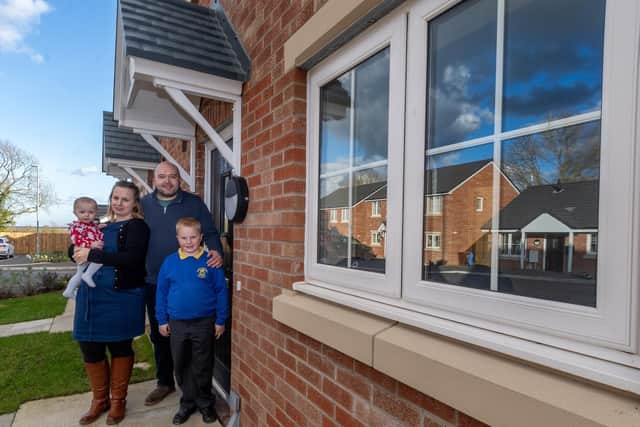Why unfair housing rules undermine Boris Johnson's 'levelling-up' mantra
The past 18 months have been a turbulent time for the young Dyson family in their struggle to get on the housing market in the scenic village of Hutton Cranswick.
Nestled in the East Riding of Yorkshire it offers an idyllic vision of community life, but increasingly the cost of homes has become divorced from local people and their incomes.
Advertisement
Hide AdAdvertisement
Hide AdAn average home in the East Riding is more than seven times the average income and according to the National Housing Federation, the average worker in the area would need a 67 per cent pay rise to be able to afford to buy a home outright.


Brendan Dyson, 34, and his wife Ellen, 27 had rented a two-bed roomed property in the village for seven years while being frozen out of home ownership.
However when Mrs Dyson fell pregnant with their second child in the summer of 2018, the professional working couple found themselves in a desperate situation due to a lack of space and spiralling rent.
"We needed to move - it was urgent," said Mr Dyson, who has lived in the village since he was three years old. "Rents in the area just kept going up and up and we knew we wouldn't have enough room when the baby was born,"


Advertisement
Hide AdAdvertisement
Hide AdMr Dyson stressed the importance for the family to remain in the village due to family ties and schooling for his seven-year-old son Riley at Hutton Primary School.
"My whole life is here," he said. "It would have been disastrous to have to leave the village. My family live here, I went to school here and my son goes to the local school."
Despite the National Market Traders Federation (NMTF) support worker and his wife both earning good wages they were unable to find a suitable property. The couple resorted to looking further afield to the neighbouring market town of Driffield.
"There are no three-bedroom houses that you can afford," he said. "I earn a good living but I still couldn't get on the property ladder.
Advertisement
Hide AdAdvertisement
Hide Ad"We did think that we would have to leave the village. I've got a lot of friends that have left the area and it seems the only option.
"We had to start looking in Driffield but they were at the top end of affordability, and we were still considering renting, but everything has just been going up in price."
The family were close to giving up hope but were thrown a "lifeline" in the form of a three-bedroom, semi-detached property through a shared ownership scheme with Together Homes.
Shared ownership allows those who wouldn’t otherwise be able to afford to buy on the open market the chance to part-buy and part-rent.
Advertisement
Hide AdAdvertisement
Hide Ad"We had actually given up in some ways," said Mr Dyson. "But we were given a lifeline when we saw this development with shared ownership.
"It took us over a year to find a house that we could afford - that is so worrying and I think it is quite disturbing really for other people who need a house in the area."
In common with many areas of Yorkshire and the wider UK, the East Riding is not seeing enough homes being built, with a recent council report admitting this shortage is impacting on the local economy.
The housing crisis gripping the nation, where an estimated 8.4 million people are living in an unaffordable, insecure or unsuitable home in England alone, impacts all ages across every part of the country.
Advertisement
Hide AdAdvertisement
Hide AdBut while the ten politicians who have held the role of Housing Minister in the last decade all insist the issue is a priority, figures show how some areas of the country get more attention from the Government than others.
And according to Homes For The North, an alliance of 17 housing associations, a lack of funding to deliver homes across northern England means many parts of the region risk losing families like the Dysons.
This trend, if allowed to continue, could ultimately undermine Prime Minister Boris Johnson's attempts to rebalance the economy as homes are built at a much faster rate in London and the South East, with 'red wall' areas of the North left behind.
Analysis from a recent report by the group into how funding for homes has been distributed shows that UK public spending on housing targeted at the North has fallen from 24 per cent of the total to 17.8 per cent over the last 20 years, with current rules meaning this could fall as low as 10 per cent.
Advertisement
Hide AdAdvertisement
Hide AdThe North has capacity to build 300,000 homes on previously developed sites, but this land supply would fulfil only 15 per cent of the homes which analysis suggests are needed to transform the region's economy.
A report by H4N says: "A mismatch between the quantity, quality and mix of housing available with the needs and aspirations of the current and future workforce could act as a brake on future growth. Pan-Northern planning could maximise the benefits of growth connecting great places to live to jobs and prosperity."
A potentially crucial obstacle to overcoming this is the so-called '80:20 rule', which governs who can bid for the billions of pounds in funding made available by government agency Homes England.
A change in criteria in 2018 means only four out of the 72 local authority areas in the North can access 80 per cent of the nearly £9bn funding Homes England hands out to deliver new homes via five separate funding streams.
Advertisement
Hide AdAdvertisement
Hide AdThe funds are targeted at the 50 per cent of local areas suffering 'high affordability pressure', calculated by comparing average house prices with average wages. The vast majority of such areas in southern England, while in the North only Hambleton, Harrogate, South Lakeland and Trafford are eligible to bid.
Other areas can only bid for the remaining 20 per cent of the money available in the Housing Infrastructure Forward Fund, Accelerated Construction Fund, Land Assembly Fund and Regeneration Fund, all of which are designed to unlock new housing.
The Government has defended its approach, saying it has to build homes where they are needed and that officials have looked "at the areas where it is most difficult to buy a home of your own".
But northern housing groups believe recent policy announcements have resulted in a funding system that will see a significant shift in resources away from the North, with funding for housing infrastructure expected to be cut by 50 per cent in the coming years.
Advertisement
Hide AdAdvertisement
Hide AdCarol Matthews, who chairs Homes for the North, says the rules as they stand at the moment are "starving the North of investment" and "running in the opposite direction of the government manifesto and their stated commitment to level up".
She said: "I absolutely believe the Conservative government in five years wants to win and retain all those northern seats they secured [in the 2019 General Election]. These rules are actually running in the opposite direction."
While housing projects are launched in the North, like South Yorkshire's 'Forge New Homes' scheme which aims to build up 500 new homes for market sale a year, the big integrated schemes are those in areas around London like the Thames Gateway and 'Oxford-Cambridge arc'.
The disparities across the country are apparent from the latest Office for National Statistics figures for completed homes built in different regions. While 7,820 homes were completed between July and September last year in the South East, only 3,600 were finished in Yorkshire and the Humber and just 1,950 in the North East.
Advertisement
Hide AdAdvertisement
Hide Ad"How you change regional inequality is these big, strategic, integrated projects of roads, rail, housing, water, doing all the flood plan stuff, in an integrated way", she says. "If you have all these fragmented projects rather than an integrated programme it's like you're picking at a scab, you're never actually sorting the problem out.
"So this artificial barrier is actually damaging Boris Johnson's chance of demonstrating that levelling up has been a reality in the life of his first term as Prime Minister."
Getting rid of the 80:20 rule would, she says, send out a strong signal to the rest of government, developers and policy-makers that areas in the South with the highest land, property and rental values should not necessarily receive the lion's share of the funding.
And she believes such a move would be welcomed in London and the South East, where the over-heating housing market now has too much high-density accommodation, not enough green space and a poor public realm. Ms Matthews concluded: "Sorting the regional imbalance is good for the South as well as being essential for the North".
Advertisement
Hide AdAdvertisement
Hide AdA spokeswoman for the Ministry of Housing Communities and Local Government said: “No areas are excluded from this Homes England funding, and we encourage applications from every area of the country.
“However we must build homes where they are most needed, and using ONS data we have looked at the areas where it is most difficult to buy a home of your own.
“It is right that we focus this funding into improving affordability in these areas where people struggle to get onto the housing ladder the most. This government is fully committed to building the houses that people need in the North, and across the country as a whole.”
